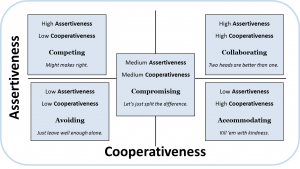Negotiate Smoothly by Understanding Conflict Styles - Part 2
Using the Thomas-Kilmann Conflict Mode Instrument (TKI) to identify five discrete styles for dealing with conflict, we just took a quick spin through each last week. Our objectives are to understand our own style preferences, to become more versatile in using other styles, and to understand and respond appropriately to our buyers’ preferred styles. This week, we’ll take a closer look at Competing and Avoiding styles.
 Contrary to popular belief, there is nothing “wrong” with these styles. Some would say that you should never, ever avoid conflict. Others would submit that entering into a conflict with a competing mindset is a sure way to lose the battle. Neither belief is true across the board. In fact, both of these styles have a clear purpose and should be used when the situation warrants it. Savvy sellers know how and when to use all five styles.
Contrary to popular belief, there is nothing “wrong” with these styles. Some would say that you should never, ever avoid conflict. Others would submit that entering into a conflict with a competing mindset is a sure way to lose the battle. Neither belief is true across the board. In fact, both of these styles have a clear purpose and should be used when the situation warrants it. Savvy sellers know how and when to use all five styles.
What Competing and Avoiding have in common is that they are low on the cooperativeness continuum. Neither of these demonstrates that a seller is interested in making sure the needs of the buyer are met.
Competing styles are stereotyped as “win at all costs” approaches. Although the level of cooperativeness is low, the level of assertiveness is high. In this style, you are asserting your own needs first and foremost. This is often viewed as the seller striving to achieve “I win, you lose” terms. Boulwarian negotiations (this is my first offer, my best offer and my only offer) typify a Competing style in the extreme.
For some, Competing comes naturally when they are embroiled in conflict… or even when there is no conflict. Hardcore competitors do love to win and may stir up conflict just for the chance to win the battle. It’s risky when this comes through in a negotiation because the other party may view this as a negative style. This style can cause people to shut down because they don’t feel there’s any way to win or to get positive result in the negotiation or conflict.
On the other hand, using a Competing style can be extremely effective when the other party opens with their own Competing style. You may need to go toe-to-toe with buyers who are Competing so as not to lose ground or respect.
It’s also important to employ a Competing style when there are terms you simply must win no matter what. For example, if a term of the agreement upholds a core value or is absolutely essential in any way, you may need to exhibit Competing tendencies to demonstrate that it is an absolute must.
The difference between Competing and Avoiding is in the level of assertiveness. When Competing, you assert your own needs. When Avoiding, you don’t assert your needs. You step out of the negotiation and choose not to be engaged.
Avoiding styles come quite naturally to some who are conflict-averse. For those who avoid conflict at all costs, there is a clear need to branch out and develop facility and comfort using other conflict styles because not engaging in appropriate conflicts and essential negotiations at all is problematic.
Likewise, those who are not adept at Avoiding conflict can develop this skill for negotiating times when it is the best choice of style.
The right time for an Avoiding style is when the other party needs to cool off or is Competing too strongly. When you can’t win, Avoiding is like taking a time out. Many negotiators intentionally use an Avoiding style to add pressure to the negotiation. If you’ve ever waited weeks to find out if your buyer would sign the contract, fretting every time your calls were not returned, you know firsthand the powerful effect this technique can have.
Both Competing and Avoiding have the inherent risk of causing your buyer to feel marginalized. Because there is a low degree of cooperativeness with these two styles, you will want to use them prudently. It is a rare negotiation that you should open with either of these two styles.
In the next post, we’ll review Compromising and Accommodating and why you should see red flags if your buyer is using these styles in a negotiation. As you work through this series, be mindful of the style(s) you typically use in conflict or negotiating and begin observing others’ styles, too. Soon you’ll be that seller others envy for your finesse in tough conversations.
This blog post is the second of four in a series on conflict styles and how to use them in negotiating.
To learn more about the TKI Assessment and how it can help you with negotiation and conflict resolution skills, please contact PFPS for coaching and training. You can also access the assessment directly at CPP.


